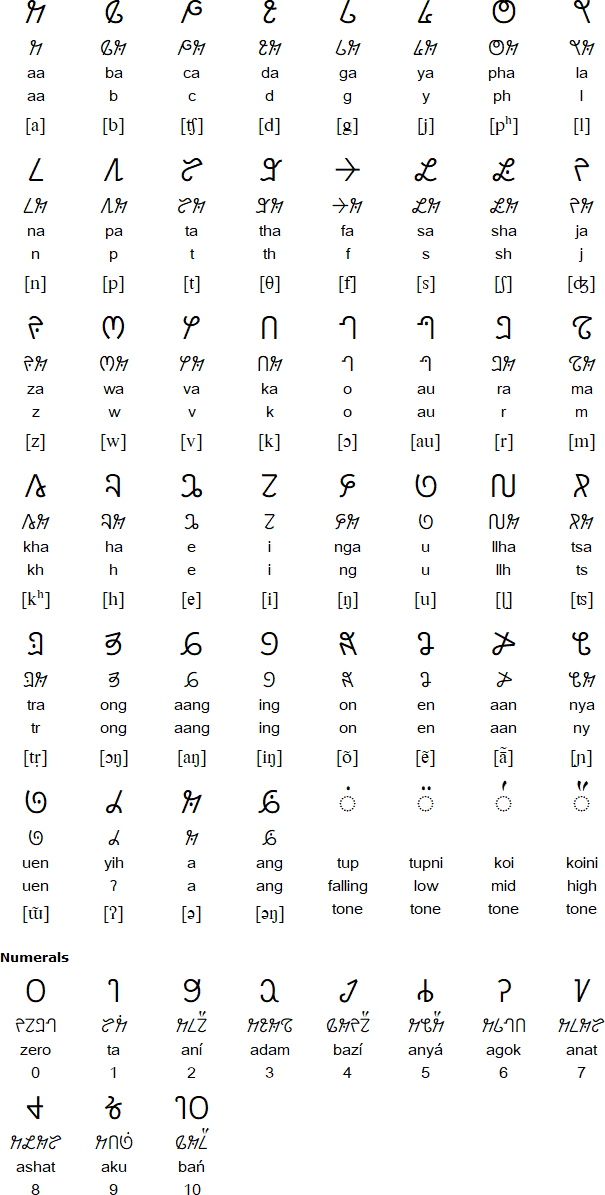The Wancho script was invented between 2001 and 2012 by Banwang Losu, a teacher from the Longding district in Arunachal Pradesh. His aim was to give the Wancho people their own script and a way to record and preserve their culture and language, which is traditionally transmitted orally. It is used to write Wancho, a Brahmaputran language spoken mainly in the Tirap district of Arunachal Pradesh in the northeast of India.
The Wancho script was added to Unicode in 2019. It is currently taught in some schools using a textbook published by Losu in 2013. Wancho is usually written with the Devanagari or Latin alphabets.

Download alphabet charts for Wancho (Excel)

Translation by Banwang Losu
खुञेक नुसा किम जाउ काउ ताम होन चा जे कान ताइः मोङ थुङ फा पुः चा नुपु, चा चा लाम गोइ का चाइ चा नाउ ला ताइः अ पाजि.
Khunyek nusaa kim jaau kau tam hon ca je kan taiʔ mong thung pha puʔ ca nupu, ca caa lam goi ka cai ca naau la taiʔ aa paji.
All human beings are born free and equal in dignity and rights. They are endowed with reason and conscience and should act towards one another in a spirit of brotherhood.
(Article 1 of the Universal Declaration of Human Rights)
Details provided by Biswajit Mandal (biswajitmandal[dot]bm90[at]gmail[dot]com)
Information about Wancho
https://en.wikipedia.org/wiki/Wancho_script
https://www.unicode.org/L2/L2017/17067r2-n4787r2-wancho.pdf
https://indianexpress.com/article/north-east-india/arunachal-pradesh/meet-banwang-losu-arunachal-man-who-scripted-history-by-creating-new-alphabet-for-ancient-tribal-language-5903790/
https://arunachaltimes.in/index.php/2019/08/08/a-decade-of-research-bears-fruit-wancho-unicode-font-developed/
A-chik Tokbirim, Adinkra, ADLaM, Armenian, Avestan, Avoiuli, Bactrian, Bassa (Vah), Beitha Kukju, Beria (Zaghawa), Borama / Gadabuursi, Carian, Carpathian Basin Rovas, Chinuk pipa, Chisoi, Coorgi-Cox, Coptic, Cyrillic, Dalecarlian runes, Elbasan, Etruscan, Faliscan, Fox, Galik, Georgian (Asomtavruli), Georgian (Nuskhuri), Georgian (Mkhedruli), Glagolitic, Global Alphabet, Gothic, Greek, Hurûf-ı munfasıla, Irish (Uncial), Kaddare, Kayah Li, Khatt-i-Badí’, Khazarian Rovas, Koch, Korean, Latin, Lepontic, Luo Lakeside Script, Lycian, Lydian, Manchu, Mandaic, Mandombe, Marsiliana, Medefaidrin, Messapic, Mongolian, Mro, Mundari Bani, Nag Chiki, Naasioi Otomaung, N'Ko, North Picene, Novo Tupi, Nyiakeng Puachue Hmong, Odùduwà, Ogham, Old Church Slavonic, Oirat Clear Script, Ol Chiki (Ol Cemet' / Santali), Old Italic, Old Nubian, Old Permic, Ol Onal, Orkhon, Osage, Oscan, Osmanya (Somali), Pau Cin Hau, Phrygian, Pollard script, Runic, Székely-Hungarian Rovás (Hungarian Runes), South Picene, Sutton SignWriting, Sunuwar, Tai Viet, Tangsa, Todhri, Toto, Umbrian, (Old) Uyghur, Wancho, Yezidi, Zoulai
Page last modified: 15.03.23
[top]
You can support this site by Buying Me A Coffee, and if you like what you see on this page, you can use the buttons below to share it with people you know.

If you like this site and find it useful, you can support it by making a donation via PayPal or Patreon, or by contributing in other ways. Omniglot is how I make my living.
Note: all links on this site to Amazon.com, Amazon.co.uk
and Amazon.fr
are affiliate links. This means I earn a commission if you click on any of them and buy something. So by clicking on these links you can help to support this site.
[top]